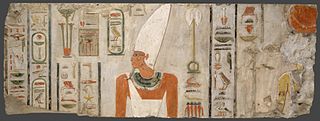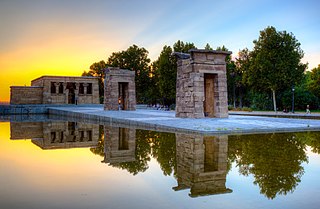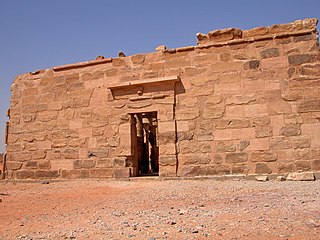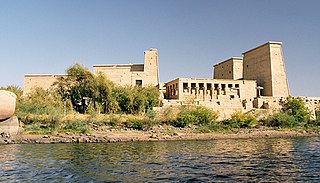
Abu Simbel is a historic site comprising two massive rock-cut temples in the village of Abu Simbel, Aswan Governorate, Upper Egypt, near the border with Sudan. It is situated on the western bank of Lake Nasser, about 230 km (140 mi) southwest of Aswan. The complex is part of the UNESCO World Heritage Site known as the "Nubian Monuments", which run from Abu Simbel downriver to Philae, and include Amada, Wadi es-Sebua, and other Nubian sites. The twin temples were originally carved out of the mountainside in the 13th century BC, during the 19th Dynasty reign of the Pharaoh Ramesses II. They serve as a lasting monument to the king Ramesses II. His wife Nefertari and children can be seen in smaller figures by his feet, considered to be of lesser importance and were not given the same position of scale. This commemorates his victory at the Battle of Kadesh. Their huge external rock relief figures have become iconic.

Psamtik II, known by the Graeco-Romans as Psammetichus or Psammeticus, was a king of the Saite-based Twenty-sixth Dynasty of Egypt. His prenomen, Nefer-Ib-Re, means "Beautiful [is the] Heart [of] Re." He was the son of Necho II.

Mentuhotep II, also known under his prenomen Nebhepetre, was an ancient Egyptian pharaoh, the sixth ruler of the Eleventh Dynasty. He is credited with reuniting Egypt, thus ending the turbulent First Intermediate Period and becoming the first pharaoh of the Middle Kingdom. He reigned for 51 years, according to the Turin King List. Mentuhotep II succeeded his father Intef III on the throne and was in turn succeeded by his son Mentuhotep III.

Dendera Temple complex is located about 2.5 kilometres (1.6 mi) south-east of Dendera, Egypt. It is one of the best-preserved temple complexes in Egypt. The area was used as the sixth nome of Upper Egypt, south of Abydos.

Mandulis was a god of ancient Nubia also worshipped in Egypt. The name Mandulis is the Greek form of Merul or Melul, a non-Egyptian name. The centre of his cult was the Temple of Kalabsha at Talmis, but he also had a temple dedicated to him at Ajuala.
New Kalabsha is a promontory located near Aswan in Egypt. It houses several important temples, structures, and other remains that have been relocated here from the site of Old Kalabsha and other sites in Lower Nubia, to avoid the rising waters of Lake Nasser caused by the construction of the Aswan High Dam. The major remains are described below:

The Temple of Dendur is a Roman Egyptian religious structure in Tuzis, Nubia about 80 kilometres (50 mi) south of modern Aswan. Around 23 BCE, Emperor Augustus commissioned the temple dedicated to the Egyptian goddess Isis and deified brothers Pedesi and Pihor from Nubia.

The Temple of Debod is an ancient Egyptian temple that was dismantled and rebuilt in the center of Madrid, Spain, in Parque de la Montaña, Madrid, a square located Calle de Irún, 21–25 Madrid.

The Temple of Edfu is an Egyptian temple located on the west bank of the Nile in Edfu, Upper Egypt. The city was known in the Hellenistic period in Koinē Greek: Ἀπόλλωνος πόλις and in Latin as Apollonopolis Magna, after the chief god Horus, who was identified as Apollo under the interpretatio graeca. It is one of the best preserved shrines in Egypt. The temple was built in the Ptolemaic Kingdom between 237 and 57 BC. The inscriptions on its walls provide important information on language, myth and religion during the Hellenistic period in Egypt. In particular, the Temple's inscribed building texts "provide details [both] of its construction, and also preserve information about the mythical interpretation of this and all other temples as the Island of Creation." There are also "important scenes and inscriptions of the Sacred Drama which related the age-old conflict between Horus and Seth." They are translated by the Edfu-Project.

The Graffito of Esmet-Akhom, also known by its designation Philae 436 or GPH 436, is the last known inscription written in Egyptian hieroglyphs, carved on 24 August AD 394. The inscription, carved in the temple of Philae in southern Egypt, was created by a priest named Nesmeterakhem and consists of a carved figure of the god Mandulis as well an accompanying text wherein Nesmeterakhem hopes his inscription will last "for all time and eternity". The inscription also contains a text in the demotic script, with similar content.

The Temple of Kalabsha is an ancient Egyptian temple that was originally located at Bab al-Kalabsha, approximately 50 km south of Aswan. The temple was inscribed on the UNESCO World Heritage List in 1979, along with other outstanding examples of Nubian architecture including Abu Simbel and Amada.

The Temple of Beit el-Wali is a rock-cut ancient Egyptian temple in Nubia which was built by Pharaoh Ramesses II and dedicated to the deities of Amun-Re, Re-Horakhti, Khnum and Anuket. It was the first in a series of temples built by Ramesses II in this region; its name Beit el-Wali means 'House of the Holy Man' and may indicate its previous use by a Christian hermit at some point in time. The temple was relocated during the 1960s as a result of the Aswan High Dam project and moved towards higher ground along with the Temple of Kalabsha. This move was coordinated with a team of Polish archaeologists financed jointly by a Swiss and Chicago Institute respectively. The temple was located 50 kilometres south of Aswan.

Wadi es-Sebua, or Valley of the Lions, is the site of two New Kingdom Egyptian temples, including one speos temple constructed by the 19th Dynasty Pharaoh Ramesses II, in Lower Nubia.

Temple of Al-Maharraqa is an ancient Egyptian Temple dedicated to Isis and Serapis. It is located in al-Maharraqa, Lower Nubia, approximately 140 km (87 mi) south of Aswan on the southern border of the Roman empire.

The temple of Gerf Hussein was dedicated to pharaoh Ramesses II and built by the Setau, Viceroy of Nubia. Situated on a bank of the Nile some 90 km south of Aswan, it was partly free-standing and partly cut from the rock. It was dedicated to "Ptah, Ptah-Tatenen and Hathor, and associated with Ramesses, 'the Great God.'"

The Temple of Amada, the oldest Egyptian temple in Nubia, was first constructed by Pharaoh Thutmose III of the 18th dynasty and dedicated to Amun and Re-Horakhty. His son and successor, Amenhotep II continued the decoration program for this structure. Amenhotep II's successor, Thutmose IV decided to place a roof over its forecourt and transform it into a pillared or hypostyle hall. During the Amarna period, Akhenaten had the name Amun destroyed throughout the temple but this was later restored by Seti I of Egypt's 19th Dynasty. Various 19th Dynasty kings especially Seti I and Ramesses II also "carried out minor restorations and added to the temple's decoration." The stelas of the Viceroys of Kush Setau, Heqanakht and Messuy and that of Chancellor Bay describe their building activities under Ramesses II, Merneptah and Siptah respectively. In the medieval period the temple was converted into a church.

Trajan's Kiosk, also known as Pharaoh's Bed by the locals, is a hypaethral temple currently located on Agilkia Island in southern Egypt. The unfinished monument is attributed to Trajan, Roman emperor from 98 to 117 AD, due to his depiction as pharaoh seen on some of the interior reliefs. However, the majority of the structure dates to an earlier time, possibly to the reign of Augustus. The temple was originally built on the island of Philae, near the lower Aswan Dam, and served as main entrance to the Philae Island Temple Complex from the Nile river. It was relocated to Agilika Island in the 1960s by UNESCO to save it from the rising waters of the Nile that followed the construction of the Aswan High Dam.

Agilkia Island is an island in the reservoir of the Old Aswan Dam along the Nile River in southern Egypt; it is the present site of the relocated ancient Egyptian temple complex of Philae. Partially to completely flooded by the old dam's construction in 1902, the Philae complex was dismantled and relocated to Agilkia island, as part of a wider UNESCO project related to the 1960s construction of the Aswan High Dam and the eventual flooding of many sites posed by its large reservoir upstream.

The Temple of Mut, also named Temple B300, is a temple at Jebel Barkal in Northern State, Sudan. It is situated about 400 km north of Khartoum near Karima and stands near a large bend of the Nile River, in the region that was called Nubia in ancient times. The partially rock-cut temple was built on the west side base of the Jebel Barkal pinnacle, from which angle it assumed the shape of an Uraeus wearing the White Crown of Upper Egypt. Dedicated to the goddess Mut, the wife of Amun, the Temple of Mut was erected by pharaoh Taharqa in the 680s BCE, at a time when he ruled Upper and Lower Egypt.



















